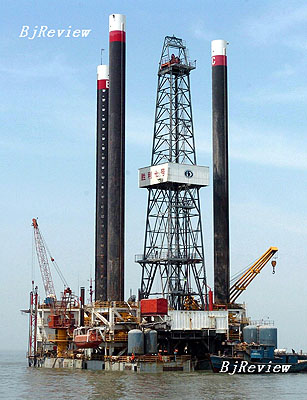
In the Caofeidian port area of Tangshan, Hebei Province, a long road stretches eastward to Bohai Bay. At the end of the road is a man-made island covering 26 hectares. Seen from the sky, the island is like a huge ship lying at anchor. Located here is a drilling platform of the China National Petroleum Corp. (CNPC). Though it cannot be found on a map of China, the place has become the focus of national attention recently. Here, after 15 years’ prospecting, a large oilfield containing around 1.02 billion tons of oil has been found.
On May 1, as the entire country was celebrating the May Day holiday, Wen Jiabao, Premier of the State Council, visited the drilling platform of Jidong Nanpu Oilfield. He said to the workers, “This is the most exciting discovery of the past 40 years in our country's oil exploration. Hearing this news, I was too excited to sleep and came here on the Labor Day to give my congratulations and show my respect.”
Excitement abounds
The discovery of an oilfield makes a premier too exited to sleep. It may be the first time this has happened in China.
On May 7, the CNPC held a press conference to announce the discovery in the Jidong Napu Oilfield. After that news broke, prices of H shares of PetroChina, a listed company under the CNPC, rose 15 percent in three days.
Hu Wenrui, Vice President of PetroChina, said that what was really exciting about the discovery is not simply the amount of oil, but the economic value and strategic significance of the oilfield derived from its location, timing of development and quality.
With the continued pace of economic development, energy security becomes a more and more significant issue for China. Statistics from the National Development and Reform Commission (NDRC) showed that in 2006, China consumed 315 million tons of oil. In that year, China exploited 184 million tons of domestic supply, while importing 145 million tons. More than 40 percent of China’s oil consumption depends on imports, and experts estimate that by 2010, that rate will reach 60 percent.
On March 29, the Ministry of Land and Resources released news that according to the survey it conducted of PetroChina, China Petroleum and Chemical Corp. (Sinopec), CNOOC Ltd., as well as oilfields affiliated to local oil companies, by the end of 2006 the country only had 2.04 billion tons of oil reserves. With the current rate of consumption, this means China’s oil reserves would be used up in 11 years.
These facts worry government officials, economists and the general public in China. “Prospecting for China's oil resources should be strengthened,” said Han Wenke, Deputy Director of the NDRC Energy Research Institute.
According to Hu Wenrui, the Jidong Nanpu Oilfield is an easily exploitable oilfield and one with extremely high efficiency. It is significant because it gives China the initiative to exploit its own oil when prices on the international market are high. In that case, Chinese development will not be restrained by crude oil price hikes on the international market. Furthermore, the exploiting cost of the Nanpu Oilfield is only $0.59 per barrel, much lower than the international average of $1.2-1.5 per barrel.
Another reason for excitement, said Hu, is that the oil beneath the large field may be far more than 1.02 billion tons. Statistics show that when Daqing Oilfield was first found in 1962, it was reported that it held just 2.2 billion tons. But now, its verified deposit has surpassed 5 billion tons.
Zhai Guangming, an oil exploration expert with the Chinese Academy of Engineering, contends that China's Bohai Bay may have reserves of 20 billion tons of oil, with half of them still undiscovered. In his opinion, the Bohai Bay rim is the second largest oil reserve area in China and, with the development of exploration technologies, China may find more and larger oilfields.
No change to energy policy
“Oil of 1.02 billion tons can be used for only four or five years and it won’t influence the present energy strategy focusing on saving energy and improving energy utilization efficiency,” said Wang Zhen, Director of the School of Business Administration in China University of Petroleum (Beijing).
Since 2001, China has attempted (as was outlined in its 10th Five-Year Plan) to strengthen implementation of energy-saving measures, improved energy utilization efficiency, transformed high-consumption enterprises, closed small and inefficient oil refineries, and developed alternative and clean energy, such as solar, wind and nuclear power. In many large cities, ethanol has begun to be used in automobiles.
| 